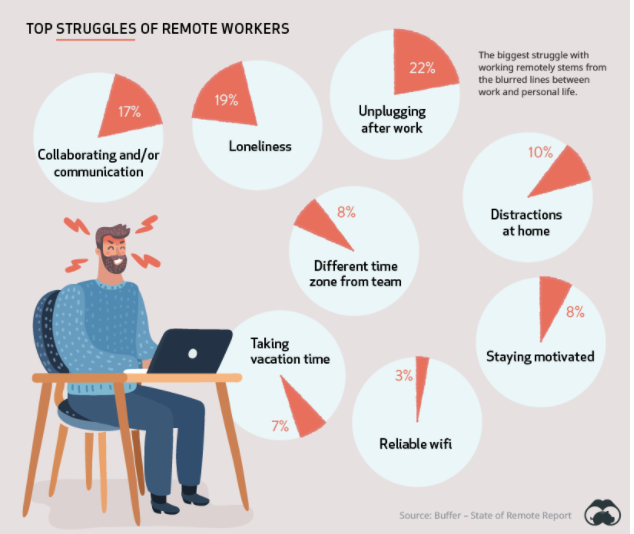Many organisations around the world had to adjust to remote working overnight due to COVID-19 pandemic, as it struck the world fast and hard. In an annual report conducted by Buffer, around 3800 people had taken a survey and it stated they were unaware of what remote working involved and how it would be suited to their role at their company.
Now that majority of companies around the globe are taking part in remote working, it begs the question – how do we make remote working work for the long run?
Company and Employee fears of remote working
It can be said that almost every company on this planet did not plan for this situation, therefore the change to their everyday work routine is severely affected.
In previous years remote working would be associated with the trusted minority of employees as companies feared they would not have constant information about their business compared to in-office employees. OWL Lab surveyed 1,202 full-time workers in the United States between the ages of 22 and 65.
This survey collected data on the biggest fear remote employee managers face, such findings included that 82% felt that the communication between their employees would become non-existent and 80% felt that employees would not work but rather binge Netflix. From their survey they captured the top concerns of managers of a remote team:
Managers have their own fears but employees have just as many fears of remote working.
Employees might find working from home a challenge due to having family responsibilities and trying to adapt their kids to homeschooling during this pandemic. The work done by employees could make them feel as if their work goes unnoticed therefore making them disengaged from work.
A home office is vital to ensure productivity but not everyone has the means to a functional home office without distractions, this could pose a challenge to some employees thus contributing to being disengaged from work. Buffer has come up with the biggest struggles employees face with working remotely.
Why has remote working has become popular?
Even though there are many challenges from a company and employee perspective of remote working, there are huge advantages as well.
The ultimate perk of remote working is flexibility. In a study conducted by Buffer and AngelList, around 98% of employees say they would like to have the option to work remotely for the rest of their careers.
There are many things that draw employees to remote working aside from flexibility, these include working from any location, no commute and being able to spend time with family. These perks extend to companies as well, as the cost saving associated with remote working may win over many companies in the future to go fully remote.
The talent pool of new employees is incredible but companies that do not embrace remote working will find themselves at a disadvantage as they will only be able to employ from a certain radius. Whereas companies that are remote, are able to employ from any part of the world.
How CleverClicks maintains company culture remotely
As a remote working company we’ve had our fair share of remote working ups and downs, but practice makes perfect and have seen the benefits of a successful remote working team.
At CleverClicks, we use various remote working tools such as Zoom and Slack to keep communication strong between employees. We’ve also seen the benefits attached to allowing flexible hours.
Here are some of the fun things we incorporate into our daily remote-working lives.
1. Pic of the day
At the end of each work day, we regroup over Zoom to maintain company culture by having a “Pic of the day”.
This is where employees submit a picture related to a specific theme to a designated person, and everyone guesses which pictures belong to who. This is an effective way to increase morale after a long day of work while simultaneously keeping up with the company culture, and getting to know something about someone you wouldn’t have guessed!

2. Zoom Socials
We’ve had Zoom socials with a crazy hat day and played various online games like Drawful.

Lockdown has brought to light workplace flexibility and the value that it can have to companies, especially with people who have kids. It is assumed that more parents would want more flexibility to spend more time with their kids by working remotely compared to working from the office pre-coronavirus.
Tobias Lütke, the CEO of Shopify, has made it known that office centricity is over and that companies need to adapt to the new norm. Even though the economy slowly reopens, we have yet to see if the COVID-19 pandemic has accelerated this trend in company workplace cultures. If so, Zoom calls with our blazers and pajama pants will become our new norm.
Why Should You Care?
Remote working has many employee and company benefits. It has been proven, if done right, a successful way of operating by many small to large size companies.
Embracing change is not always an easy feat, but as we know, it can lead to more productive ways of working as a company and further improve the way we work.
Do you have any remote-working tips? Drop us a comment below!
Tags: company culture, COVID-19, online business, remote working
Stay In The Know
Cut the clutter and stay on top of important news like this. We handpick the single most noteworthy news of the week and send it directly to subscribers. Join the club to stay in the know…






